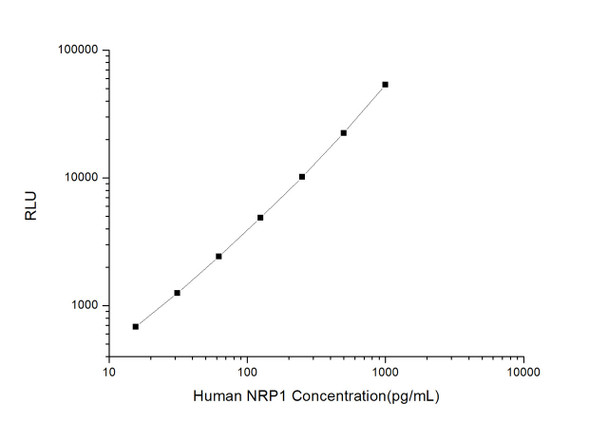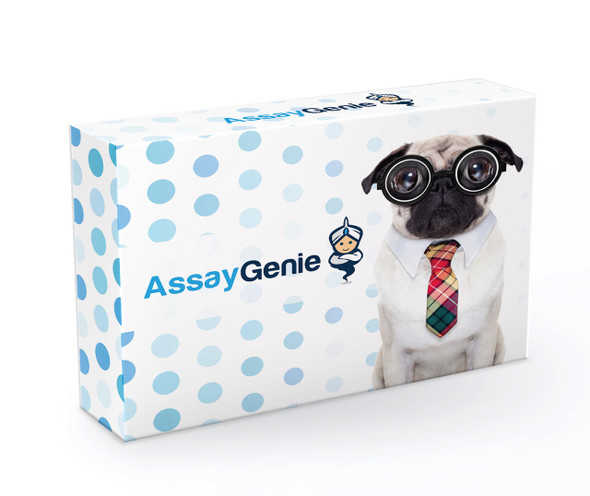Human Cardiovascular ELISA Kits
Human NRP1 (Neuropilin 1) CLIA Kit (HUES00709)
- SKU:
- HUES00709
- Product Type:
- ELISA Kit
- ELISA Type:
- CLIA Kit
- Size:
- 96 Assays
- Sensitivity:
- 9.38pg/mL
- Range:
- 15.63-1000pg/mL
- ELISA Type:
- Sandwich
- Reactivity:
- Human
- Sample Type:
- Serum, plasma and other biological fluids
- Research Area:
- Cardiovascular
Description
| Assay type: | Sandwich |
| Format: | 96T |
| Assay time: | 4.5h |
| Reactivity: | Human |
| Detection method: | Chemiluminescence |
| Detection range: | 15.63-1000 pg/mL |
| Sensitivity: | 9.38 pg/mL |
| Sample volume: | 100µL |
| Sample type: | Serum, plasma and other biological fluids |
| Repeatability: | CV < 15% |
| Specificity: | This kit recognizes Human NRP1 in samples. No significant cross-reactivity or interference between Human NRP1 and analogues was observed. |
This kit uses Sandwich-CLIA as the method. The micro CLIA plate provided in this kit has been pre-coated with an antibody specific to Human NRP1. Standards or samples are added to the appropriate micro CLIA plate wells and combined with the specific antibody. Then a biotinylated detection antibody specific for Human NRP1 and Avidin-Horseradish Peroxidase (HRP) conjugate are added to each micro plate well successively and incubated. Free components are washed away. The substrate solution is added to each well. Only those wells that contain Human NRP1, biotinylated detection antibody and Avidin-HRP conjugate will appear fluorescence. The Relative light unit (RLU) value is measured spectrophotometrically by the Chemiluminescence immunoassay analyzer. The RLU value is positively associated with the concentration of Human NRP1. The concentration of Human NRP1 in the samples can be calculated by comparing the RLU of the samples to the standard curve.
| UniProt Protein Function: | NRP1: The membrane-bound isoform 1 is a receptor involved in the development of the cardiovascular system, in angiogenesis, in the formation of certain neuronal circuits and in organogenesis outside the nervous system. It mediates the chemorepulsant activity of semaphorins. It binds to semaphorin 3A, The PLGF-2 isoform of PGF, The VEGF-165 isoform of VEGF and VEGF-B. Coexpression with KDR results in increased VEGF-165 binding to KDR as well as increased chemotaxis. It may regulate VEGF-induced angiogenesis. Homodimer, and heterodimer with NRP2. Interacts with FER. Binds PLXNB1. The expression of isoforms 1 and 2 does not seem to overlap. Isoform 1 is expressed by the blood vessels of different tissues. In the developing embryo it is found predominantly in the nervous system. In adult tissues, it is highly expressed in heart and placenta; moderately in lung, liver, skeletal muscle, kidney and pancreas; and low in adult brain. Isoform 2 is found in liver hepatocytes, kidney distal and proximal tubules. Belongs to the neuropilin family. 2 isoforms of the human protein are produced by alternative splicing. |
| UniProt Protein Details: | Protein type:Membrane protein, integral; Receptor, misc. Chromosomal Location of Human Ortholog: 10p12 Cellular Component: axon; cytoplasmic vesicle; cytosol; early endosome; extracellular space; focal adhesion; plasma membrane; receptor complex Molecular Function:coreceptor activity; growth factor binding; protein binding; vascular endothelial growth factor receptor activity Biological Process: angiogenesis; artery morphogenesis; axon extension involved in axon guidance; cell migration during sprouting angiogenesis; cell-cell signaling; hepatocyte growth factor receptor signaling pathway; nerve development; neuron migration; organ morphogenesis; patterning of blood vessels; platelet-derived growth factor receptor signaling pathway; positive chemotaxis; positive regulation of axon extension involved in axon guidance; positive regulation of endothelial cell proliferation; positive regulation of peptidyl-tyrosine phosphorylation; positive regulation of smooth muscle cell migration; retinal ganglion cell axon guidance; signal transduction; sprouting angiogenesis; vascular endothelial growth factor receptor signaling pathway |
| NCBI Summary: | This gene encodes one of two neuropilins, which contain specific protein domains which allow them to participate in several different types of signaling pathways that control cell migration. Neuropilins contain a large N-terminal extracellular domain, made up of complement-binding, coagulation factor V/VIII, and meprin domains. These proteins also contains a short membrane-spanning domain and a small cytoplasmic domain. Neuropilins bind many ligands and various types of co-receptors; they affect cell survival, migration, and attraction. Some of the ligands and co-receptors bound by neuropilins are vascular endothelial growth factor (VEGF) and semaphorin family members. Several alternatively spliced transcript variants that encode different protein isoforms have been described for this gene. [provided by RefSeq, Oct 2011] |
| UniProt Code: | O14786 |
| NCBI GenInfo Identifier: | 206729912 |
| NCBI Gene ID: | 8829 |
| NCBI Accession: | O14786. 3 |
| UniProt Secondary Accession: | O14786,O60461, Q5T7F1, Q5T7F2, Q5T7F3, Q86T59, Q96I90 Q96IH5, B0LPG9, |
| UniProt Related Accession: | O14786 |
| Molecular Weight: | 68,376 Da |
| NCBI Full Name: | Neuropilin-1 |
| NCBI Synonym Full Names: | neuropilin 1 |
| NCBI Official Symbol: | NRP1 |
| NCBI Official Synonym Symbols: | NP1; NRP; BDCA4; CD304; VEGF165R |
| NCBI Protein Information: | neuropilin-1 |
| UniProt Protein Name: | Neuropilin-1 |
| UniProt Synonym Protein Names: | Vascular endothelial cell growth factor 165 receptor; CD_antigen: CD304 |
| Protein Family: | Neuropilin |
| UniProt Gene Name: | NRP1 |
| UniProt Entry Name: | NRP1_HUMAN |
As the RLU values of the standard curve may vary according to the conditions of the actual assay performance (e. g. operator, pipetting technique, washing technique or temperature effects), the operator should establish a standard curve for each test. Typical standard curve and data is provided below for reference only.
| Concentration (pg/mL) | RLU | Average | Corrected |
| 1000 | 51557 55793 | 53675 | 53650 |
| 500 | 21131 23847 | 22489 | 22464 |
| 250 | 10530 9892 | 10211 | 10186 |
| 125 | 4579 5223 | 4901 | 4876 |
| 62.5 | 2496 2410 | 2453 | 2428 |
| 31.25 | 1293 1269 | 1281 | 1256 |
| 15.63 | 667 749 | 708 | 683 |
| 0 | 24 26 | 25 | -- |
Precision
Intra-assay Precision (Precision within an assay): 3 samples with low, mid range and high level Human NRP1 were tested 20 times on one plate, respectively.
Inter-assay Precision (Precision between assays): 3 samples with low, mid range and high level Human NRP1 were tested on 3 different plates, 20 replicates in each plate.
| Intra-assay Precision | Inter-assay Precision | |||||
| Sample | 1 | 2 | 3 | 1 | 2 | 3 |
| n | 20 | 20 | 20 | 20 | 20 | 20 |
| Mean (pg/mL) | 51.58 | 146.97 | 353.82 | 56.30 | 134.77 | 355.49 |
| Standard deviation | 5.17 | 14.46 | 39.52 | 5.64 | 15.85 | 39.64 |
| C V (%) | 10.02 | 9.84 | 11.17 | 10.02 | 11.76 | 11.15 |
Recovery
The recovery of Human NRP1 spiked at three different levels in samples throughout the range of the assay was evaluated in various matrices.
| Sample Type | Range (%) | Average Recovery (%) |
| Serum (n=5) | 95-109 | 103 |
| EDTA plasma (n=5) | 101-117 | 107 |
| Cell culture media (n=5) | 98-115 | 106 |
Linearity
Samples were spiked with high concentrations of Human NRP1 and diluted with Reference Standard & Sample Diluent to produce samples with values within the range of the assay.
| Serum (n=5) | EDTA plasma (n=5) | Cell culture media (n=5) | ||
| 1:2 | Range (%) | 88-99 | 92-104 | 97-110 |
| Average (%) | 93 | 97 | 102 | |
| 1:4 | Range (%) | 92-104 | 99-115 | 97-107 |
| Average (%) | 98 | 107 | 102 | |
| 1:8 | Range (%) | 85-98 | 94-110 | 84-97 |
| Average (%) | 91 | 102 | 91 | |
| 1:16 | Range (%) | 97-110 | 86-98 | 89-103 |
| Average (%) | 104 | 91 | 96 |
An unopened kit can be stored at 4°C for 1 month. If the kit is not used within 1 month, store the items separately according to the following conditions once the kit is received.
| Item | Specifications | Storage |
| Micro CLIA Plate(Dismountable) | 8 wells ×12 strips | -20°C, 6 months |
| Reference Standard | 2 vials | |
| Concentrated Biotinylated Detection Ab (100×) | 1 vial, 120 µL | |
| Concentrated HRP Conjugate (100×) | 1 vial, 120 µL | -20°C(shading light), 6 months |
| Reference Standard & Sample Diluent | 1 vial, 20 mL | 4°C, 6 months |
| Biotinylated Detection Ab Diluent | 1 vial, 14 mL | |
| HRP Conjugate Diluent | 1 vial, 14 mL | |
| Concentrated Wash Buffer (25×) | 1 vial, 30 mL | |
| Substrate Reagent A | 1 vial, 5 mL | 4°C (shading light) |
| Substrate Reagent B | 1 vial, 5 mL | 4°C (shading light) |
| Plate Sealer | 5 pieces | |
| Product Description | 1 copy | |
| Certificate of Analysis | 1 copy |
- Set standard, test sample and control (zero) wells on the pre-coated plate and record theirpositions. It is recommended to measure each standard and sample in duplicate. Note: addall solutions to the bottom of the plate wells while avoiding contact with the well walls. Ensuresolutions do not foam when adding to the wells.
- Aliquot 100µl of standard solutions into the standard wells.
- Add 100µl of Sample / Standard dilution buffer into the control (zero) well.
- Add 100µl of properly diluted sample (serum, plasma, tissue homogenates and otherbiological fluids. ) into test sample wells.
- Cover the plate with the sealer provided in the kit and incubate for 90 min at 37°C.
- Aspirate the liquid from each well, do not wash. Immediately add 100µL of BiotinylatedDetection Ab working solution to each well. Cover the plate with a plate seal and gently mix. Incubate for 1 hour at 37°C.
- Aspirate or decant the solution from the plate and add 350µL of wash buffer to each welland incubate for 1-2 minutes at room temperature. Aspirate the solution from each well andclap the plate on absorbent filter paper to dry. Repeat this process 3 times. Note: a microplatewasher can be used in this step and other wash steps.
- Add 100µL of HRP Conjugate working solution to each well. Cover with a plate seal andincubate for 30 min at 37°C.
- Aspirate or decant the solution from each well. Repeat the wash process for five times asconducted in step 7.
- Add 100µL of Substrate mixture solution to each well. Cover with a new plate seal andincubate for no more than 5 min at 37°C. Protect the plate from light.
- Determine the RLU value of each well immediately.






